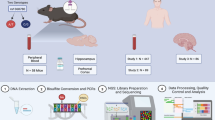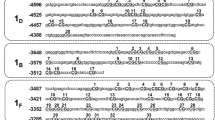Abstract
FKBP5 encodes a co-chaperone of HSP90 protein that regulates intracellular glucocorticoid receptor sensitivity. When it is bound to the glucocorticoid receptor complex, cortisol binds with lower affinity to glucocorticoid receptor. Cushing’s syndrome is associated with memory deficits, smaller hippocampal volumes, and wide range of cognitive impairments. We aimed at evaluating blood DNA methylation of FKBP5 and its relationship with memory and hippocampal volumes in Cushing’s syndrome patients. Polymorphism rs1360780 in FKBP5 has also been assessed to determine whether genetic variations can also govern CpG methylation. Thirty-two Cushing’s syndrome patients and 32 matched controls underwent memory tests, 3-Tesla MRI of the brain, and DNA extraction from total leukocytes. DNA samples were bisulfite treated, PCR amplified, and pyrosequenced to assess a total of 41CpG-dinucleotides in the introns 1, 2, 5, and 7 of FKBP5. Significantly lower intronic FKBP5 DNA methylation in CS patients compared to controls was observed in ten CpG-dinucleotides. DNA methylation at these CpGs correlated with left and right HV (Intron-2-Region-2-CpG-3: LHV, r = 0.73, p = 0.02; RHV, r = 0.58, p = 0.03). Cured and active CS patients showed both lower methylation of intron 2 (92.37, 91.8, and 93.34 %, respectively, p = 0.03 for both) and of intron 7 (77.08, 73.74, and 79.71 %, respectively, p = 0.02 and p < 0.01) than controls. Twenty-two subjects had the CC genotype, 34 had the TC genotype, and eight had the TT genotype. Lower average DNA methylation in intron 7 was observed in the TT subjects compared to CC (72.5vs. 79.5 %, p = 0.02) and to TC (72.5 vs. 79.0 %, p = 0.03). Our data demonstrate, for the first time, a reduction of intronic DNA methylation of FKBP5 in CS patients.





Similar content being viewed by others
Abbreviations
- FKBP5:
-
human protein
- FKBP5 :
-
human gene
- FKBP5:
-
mouse protein
- Fkbp5 :
-
mouse gene
References
W.B. Pratt, D.O. Toft, Steroid receptor interactions with heat shock protein and immunophilin chaperones. Endocr. Rev. 18, 306–360 (1997)
E.B. Binder, The role of FKBP5, a co-chaperone of the glucocorticoid receptor in the pathogenesis and therapy of affective and anxiety disorders. Psychoneuroendocrinology 34, 186–195 (2009)
C.M. Pariante, A.H. Miller, Glucocorticoid receptors in major depression: relevance to pathophysiology and treatment. Biol. Psychiatry 49, 391–404 (2001)
R.S. Lee, K.L. Tamashiro, X. Yang, R.H. Purcell, A. Harvey, V.L. Willour, Y. Huo, M. Rongione, G.S. Wand, J.B. Potash, Chronic corticosterone exposure increases expression and decreases deoxyribonucleic acid methylation of FKBP5 in mice. Endocrinology 151, 4332–4343 (2010)
M. Joëls, H. Karst, H.J. Krugers, P.J. Lucassen, Chronic stress: implications for neuronal morphology, function and neurogenesis. Front. Neuroendocrinol. 28, 72–96 (2007)
T. Fujii, H. Hori, M. Ota, K. Hattori, T. Teraishi, D. Sasayama, N. Yamamoto, T. Higuchi, H. Kunugi, Effect of the common functional FKBP5 variant (rs1360780) on the hypothalamic-pituitary-adrenal axis and peripheral blood gene expression. Psychoneuroendocrinology 42, 89–97 (2014)
T. Fujii, M. Ota, H. Hori, K. Hattori, T. Teraishi, D. Sasayama, T. Higuchi, H. Kunugi, Association between the common functional FKBP5 variant (rs1360780) and brain structure in a non-clinical population. J. Psychiatr. Res. 58, 96–101 (2014)
E.B. Binder, D. Salyakina, P. Lichtner, G.M. Wochnik, M. Ising, B. Pütz, S. Papiol, S. Seaman, S. Lucae, M.A. Kohli et al., Polymorphisms in FKBP5 are associated with increased recurrence of depressive episodes and rapid response to antidepressant treatment. Nat. Genet. 36, 1319–1325 (2004)
T. Klengel, D. Mehta, C. Anacker, M. Rex-Haffner, J.C. Pruessner, C.M. Pariante, T.W. Pace, K.B. Mercer, H.S. Mayberg, B. Bradley et al., Allele-specific FKBP5 DNA demethylation mediates gene-childhood trauma interactions. Nat. Neurosci. 16, 33–41 (2013)
E.B. Binder, R.G. Bradley, W. Liu, M.P. Epstein, T.C. Deveau, K.B. Mercer, Y. Tang, C.F. Gillespie, C.M. Heim, C.B. Nemeroff et al., Association of FKBP5 polymorphisms and childhood abuse with risk of posttraumatic stress disorder symptoms in adults. JAMA 299, 1291–1305 (2008)
E. Resmini, A. Santos, B. Gómez-Anson, Y. Vives, P. Pires, I. Crespo, M.J. Portella, M. de Juan-Delago, M.J. Barahona, S.M. Webb, Verbal and visual memory performance and hippocampal volumes, measured by 3-Tesla magnetic resonance imaging, in patients with Cushing’s syndrome. J. Clin. Endocrinol. Metab. 97, 663–671 (2012)
E.S. Brown, H. Jeon-Slaughter, H. Lu, R. Jamadar, S. Issac, M. Shad, D. Denniston, C. Tamminga, A. Nakamura, B.P. Thomas, Hippocampal volume in healthy controls given 3-day stress doses of hydrocortisone. Neuropsychopharmacology 40, 1216–1221 (2015)
E. Resmini, A. Santos, B. Gómez-Anson, O. López-Mourelo, P. Pires, Y. Vives-Gilabert, I. Crespo, M.J. Portella, M. de Juan-Delago, S.M. Webb, Hippocampal dysfunction in cured Cushing’s syndrome patients, detected by 1H-MR-spectroscopy. Clin. Endocrinol. (Oxf) 79, 700–707 (2013)
A. Bird, DNA methylation patterns and epigenetic memory. Genes & Dev. 16, 6–21 (2002)
E.R. Ewald, G.S. Wand, F. Seifuddin, X. Yang, K.L. Tamashiro, J.B. Potash, P. Zandi, R.S. Lee, Alterations in DNA methylation of FKBP5 as a determinant of blood-brain correlation of glucocorticoid exposure. Psychoneuroendocrinology 44, 112–122 (2014)
T. den Heijer, S.E. Vermeer, E.J. van Dijk, N.D. Prins, P.J. Koudstaal, A. Hofman, M.M. Breteler, Type 2 diabetes and atrophy of the medial temporal lobe structures on brain MRI. Diabetologia 46, 1604–1610 (2003)
H. Bruehla, O.T. Wolf, A. Convita, A blunted cortisol awakening response and hippocampal atrophy in type 2 diabetes mellitus. Psychoneuroendocrinology 34, 815–821 (2009)
S.M. Gold, I. Dziobek, V. Sweat, A. Tirsi, K. Rogers, H. Bruehl, W. Tsui, S. Richardson, E. Javier, A. Convit, Hippocampal damage and memory impairments as possible early brain complications of type 2 diabetes. Diabetologia. 50, 711–719 (2007)
V. Popovic, S. Pekic, D. Pavlovic, N. Maric, M. Jasovic-Gasic, B. Djurovic, M. Medic Stojanoska, V. Zivkovic, M. Stojanovic, M. Doknic et al., Hypopituitarism as a consequence of traumatic brain injury (TBI) and its possible relation with cognitive disabilities and mental distress. J. Endocrinol. Invest. 27, 1048–1054 (2004)
J. Sambrook, E.F. Fritschi, T. Maniatis, Molecular Cloning: A Laboratory Manual, vol. 1, 2nd ed. Cold Spring Harbor Laboratory Press, New York, 1989, p 1659
S. Colella, L. Shen, K.A. Baggerly, J.P. Issa, R. Krahe, Sensitive and quantitative universal pyrosequencing methylation analysis of CpG sites. Biotechniques 35, 146–150 (2003)
E. Shumay, J. Logan, N.D. Volkow, J.S. Fowler, Evidence that the methylation state of the monoamine oxidase A (MAOA) gene predicts brain activity of MAO A enzyme in healthy men. Epigenetics 7, 1151–1160 (2012)
A.S. Zannas, T. Wiechmann, N.C. Gassen, E.B. Binder, Gene-stress-epigenetic regulation of FKBP5: Clinical and translational implications. Neuropsychopharmacology 41, 261–274 (2016)
T.C. Durazzo, D.J. Meyerhoff, S.J. Nixon, Interactive effects of chronic cigarette smoking and age on hippocampal volumes. Drug Alcohol Depend. 133, 704–711 (2013)
M.V. Dogan, M.K. Lei, S.R. Beach, G.H. Brody, R.A. Philibert, Alcohol and tobacco consumption alter hypothalamic pituitary adrenal axis DNA methylation. Psychoneuroendocrinology 66, 176–184 (2016)
S. Gelfman, N. Cohen, A. Yearim, G. Ast, DNA-methylation effect on cotranscriptional silencing is dependent on GC architecture of the exon-intron structure. Genome Research 5, 789–799 (2013)
N. Fani, D. Gutman, E.B. Tone, L. Almli, K.B. Mercer, J. Davis, E. Glover, T. Jovanovic, B. Bradley, I.D. Dinov, A. Zamanyan, A.W. Toga, E.B. Binder, K.J. Ressler, FKBP5 and attention bias for threat: associations with hippocampal function and shape. JAMA Psychiatry 70, 392–400 (2013)
T. Fujii, M. Ota, H. Hori, K. Hattori, T. Teraishi, D. Sasayama, T. Higuchi, H. Kunugi, Association between the common functional FKBP5 variant (rs1360780) and brain structure in a non-clinical population. J. Psychiatr. Res. 58, 96–101 (2014)
L. Tozzi, A. Carballedo, F. Wetterling, H. McCarthy, V. O’Keane, M. Gill, D. Morris, C. Fahey, J. Meaney, T. Frodl, Single-nucleotide polymorphism of the FKBP5 gene and childhood maltreatment as predictors of structural changes in brain areas involved in emotional processing in depression. Neuropsychopharmacology 41, 487–497 (2016)
R.S. Lee, K.L. Tamashiro, M.J. Aryee, P. Murakami, F. Seifuddin, B. Herb, Y. Huo, M. Rongione, A.P. Feinberg, T.H. Moran, J.B. Potash, Adaptation of the CHARM DNA methylation platform for the rat genome reveals novel brain region-specific differences. Epigenetics 6, 1378–1390 (2011)
B. Hing, E. Ramos, P. Braun, M. McKane, D. Jancic, K.L. Tamashiro, R.S. Lee, J.J. Michaelson, T.E. Druley, J.B. Potash, Adaptation of the targeted capture Methyl-Seq platform for the mouse genome identifies novel tissue-specific DNA methylation patterns of genes involved in neurodevelopment. Epigenetics 10, 581–596 (2015)
Acknowledgments
This work was supported by the Instituto de Salud Carlos III, Spanish Ministry of Science and Innovation (MICINN, FIS080302), NIH U01AA020890, K05AA020342 (GSW) and R21MH101392 (RSL), and the European Commission (ERCUSYN PHP800200). We thank Dr. Ignasi Gich, from the Department of Epidemiology of the Hospital Sant Pau, for the critical review of the statistical analysis. The collaboration of the patients and controls who participated in this study is also acknowledged.
Author information
Authors and Affiliations
Corresponding author
Ethics declarations
Conflictof interest
The authors declare that they have no conflicting interests.
Electronic supplementary material
Rights and permissions
About this article
Cite this article
Resmini, E., Santos, A., Aulinas, A. et al. Reduced DNA methylation of FKBP5 in Cushing’s syndrome. Endocrine 54, 768–777 (2016). https://doi.org/10.1007/s12020-016-1083-6
Received:
Accepted:
Published:
Issue Date:
DOI: https://doi.org/10.1007/s12020-016-1083-6




